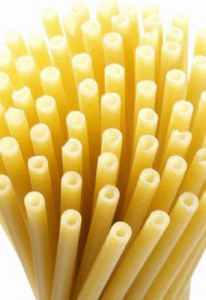
Italian Bucatini Pasta
At BevX I like to offer up favorite recipes to our hungry and thirsty readers. I refrain from overloading the content with food recipes but the numbers don’t lie — our readers really eat up the recipes and simply tolerate the bad puns.
Today, before revealing the recipe I must make a confession. I do withhold a number of favorite recipes for fear that it will become a rant. I am troubled, far more than warranted, when my favorite dishes are destroyed by well-meaning but uninformed cooks.
Pasta Amatriciana (or all’amatriciana) is part of the holy trinity of pasta dishes in Rome along with cacio e pepe and carbonara. Sadly, all three recipes are often butchered outside of Italy. Logic would dictate that the simplicity of these dishes virtually assures their proper execution but sadly this is not the case.
The ugly truth is that non-Italians, Americans very much included (even those with Italian surnames), make a mess of pasta dishes. The first problem is that too many people fail to realize that the pasta is the star and the sauce is the condiment. This leads to the purchase of cheap pasta and cooking it to a point where it is nearly disintegrating. According to real Italian chefs, pasta is either raw, perfect, or over-cooked. Aim for perfect. Buy a quality pasta and cook it according to the instructions in boiling, salted water.
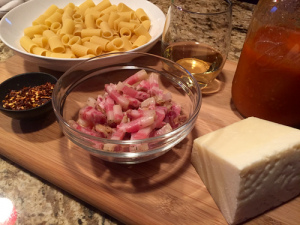
Pasta Amatriciana Set-up
The second problem is over saucing and pairing a sauce with the wrong pasta. Americans have wrongly been taught that pasta shapes and sizes are a thing of whimsy and you should pick the shape that amuses you on that day. In part, I blame the Olive Garden that asks their guests to pick a pasta and then to choose a sauce and perhaps a topping like meatballs or chicken. This is a concept that will make an Italian chef visibly enraged. Pasta shapes and sizes are complimented by particular sauces and wholly incompatible with others. Have it your way may be a catchy slogan but it’s not a road map for understanding a foreign cuisine. (Spaghetti and meatballs is an American invention. In Italy these are two separate dishes.)
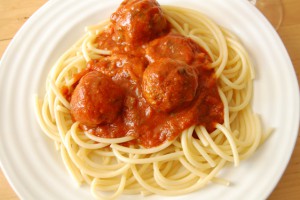
Pasta American Style
Another issue regarding pasta in America is the relationship of the pasta and the sauce. Far too often I see pasta and sauce that have first met on the plate. Pasta is meant to finish its last minute or so of cooking in the sauce. Again, the sauce is a condiment not a soup so there should be just enough sauce to generously cling to each piece of al dente pasta. The pasta absorbs a small bit of sauce and a small bit of starch is released into the sauce creating the perfect creamy texture. If you are mounding the pasta on the plate then topping it with sauce and a meat dish – you’re doing it wrong.
Like most authentic Italian dishes the secret lies in a small number of high quality ingredients combined with care. This is why you can sit down in an unassuming restaurant in Rome and eat a $10 plate of pasta that will nearly bring you to tears.
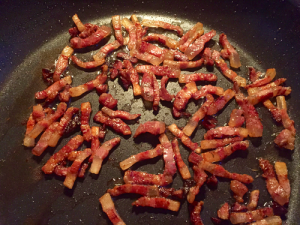
Guanciale Loves Pasta
All right — if I have not lost you let’s get on to the amatriciana. Amatriciana is a simple but delicious sauce of guanciale (cured pork jowl), fresh tomato sauce, and Pecorino Romano cheese with white wine and pepper flakes in support. That’s it.
As mentioned, the sauce must compliment the pasta and vice versa. The traditional pasta pairing with amatriciana is bucatini — a long pasta that looks like a fat spaghetti with a hollow center. This pasta marries perfectly with amatriciana but many Roman restaurants are using short tube pastas resembling a small rigatoni. In my view this shape is a great match but it is not traditional. Below in the ingredients I recommend my choice for a short sleeve pasta if not using bucatini.
- 1 teaspoon Olive Oil
- 6 to 8 ounces Guanciale cut into 1/4 inch strips (substitute bacon or pancetta but it won’t be as good)
- 1/2 teaspoon red pepper flakes
- 1 pint of fresh tomato sauce or crushed tomatoes
- 4 ounces of dry white wine (no oak)
- 1/2 cup grated Pecorino Romano (more for serving)
- 1 pound of dried bucatini (or short tube pasta, I use Garofalo Mezzo Maniche Rigate #32)
Heat a large pan, large enough to accommodate the sauce and all of the cooked pasta, over medium-high heat.
Bring four to six quarts of water in a pasta or stock pot to a boil. Once the water is at a boil add a couple of tablespoons of kosher or sea salt to the water. Italians say that pasta cooking water should taste like sea water.
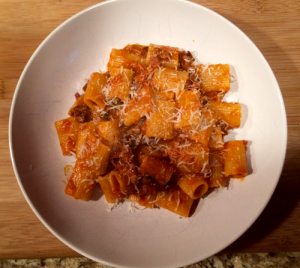
Italian Pasta Amatriciana Served
To the pan, add the olive oil and guanciale and cook until the guanciale becomes a bit crisp being careful to not overcook or burn the meat. At this point add the red pepper flake and the wine to the pan and deglaze, loosening any bits that may have stuck to the pan. Reduce the wine volume by half and then add the tomato sauce.
Cook the sauce over medium heat.
Cook your pasta following the instructions on the package. A quality bucatini will take about nine minutes to cook. When you cook a dried pasta shape and brand for the first time be sure to check it a couple of minutes before the expected finish time. Once experienced cooking a pasta and a sauce together you will develop a timing for when to drop the pasta into the water. Until then, have the sauce ready to go as you can wait on the sauce but perfectly cooked pasta waits for no one.
When the pasta is al dente and nearly perfect add it to the sauce along with a ladle of the pasta cooking water. Increase the sauce pan to high heat. Fold the pasta into the sauce and cook for 30 to 60 seconds. Taste a piece of pasta — if perfect switch off the heat and add the cheese, tossing to combine.
Serve at once in warm plates or bowls with additional grated cheese. Enjoy and repeat – the more you make this dish the better your results.
Great wine pairings with your pasta amatriciana are a very local Cesanese (Lazio red wine) and a Montefalco Rosso from nearby Umbria.
